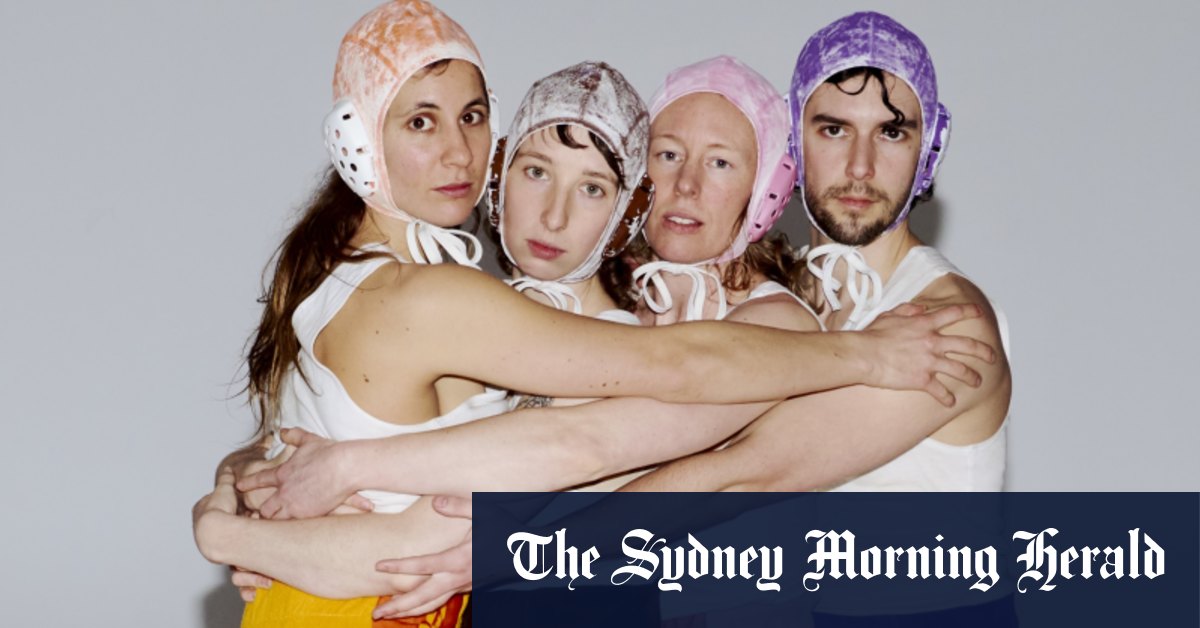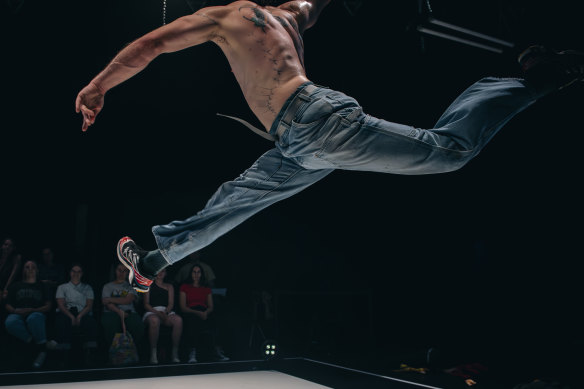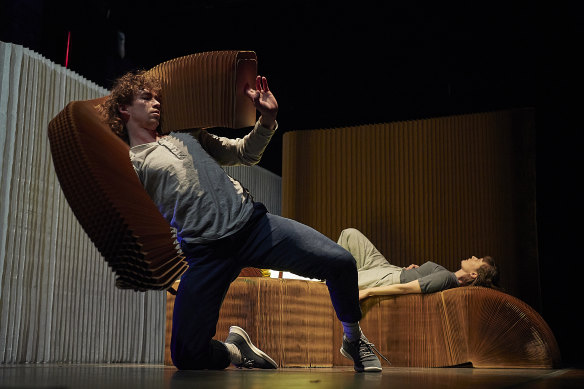
Last year choreographer Harrison Ritchie-Jones staged a short version of his upcoming show TANTRUM for 6. Some audience members told him it made them want to go home and scream. They meant it as the highest praise.
Anyone familiar with the young dance maker’s works will know that they can elicit very unusual responses. Like laughter, for instance. Contemporary dance that’s actually funny is one of the hardest moves to pull off, but a Ritchie-Jones piece always seems to have a level of absurdity baked into it.
Take CUDDLE, in which two balaclava-clad crims on the run wrestle, embrace, strip and strut. Or Big Wig Small Gig, a high-camp courtship melodrama whose movement is informed by Brazilian jiu jitsu and barnyard rodeos, among other things. There’s his spaghetti western-inspired short film Banshee Cried Silver, and the imminent TANTRUM for 6, in which a gang of babies born from a thunderstorm enact their strange life cycle.
It’s not that he deliberately aims for comedy. “I’m not really making anything to be funny. I am amused by things when I’m making them. But there’s already so many more layers that have happened before it becomes funny.”

Harrison Ritchie-Jones in Cuddle.Credit: Gregory Lorenzutti
The layering metaphor is one that’s key to his practice – he describes each work as a “strange lasagne”. For a long time he’ll follow his instincts down whatever rabbit hole catches his interest, especially if it involves a form of movement traditionally excluded from contemporary dance.
In developing TANTRUM for 6, for instance, Ritchie-Jones has looked to mixed martial arts, figure skating, Latin social dances, TikTok reels, boxing footwork and Riverdance.
“I never really see them as isolated things, doing them in the way that they’re known. The real interest is this overlap of logic that they all share, which is to do with negotiating weight, suspending it and redirecting it.”
Loading
What fascinates him is the way that each of these forms of movement has a different focus when it comes to the weight of the human body: some hope to escape gravity in order to appear more graceful, while others submit to its demands to add heft to a move. In some, you’re just aiming for a perfect score. To flip between those different intentions within the same movement has a transformative effect, he says.
“It does something to your focus and your body when you’re switching mindsets to pull them off … it’s coming in as a figure skating move and then turning into a wrestling move but before it hits the ground it goes back into salsa and then it turns into some kind of goblin run. It’s creating this really unpredictable virtuosic movement vocabulary.”
If his work does induce laughs, they’re the sort that well up when you witness dancers going somewhere you don’t fully understand. It’s the joy of witnessing abandon in an artform that is typically so precise and meticulous. “It’s the permission that I’m giving myself and the dancers, and in turn to the audience. Permission to sit with things that are strange. You get a nervous laugh from that. Or if you see something surprising and epic you also laugh. You laugh when you’re processing things.”
He likes the energy a little chaos can bring to the development of work, and that often makes its way into the final product. “I embrace it. I’m attracted to it. A bit of strangeness usually stays in. Mistakes stay if I like them, if they’re more interesting.”
Ritchie-Jones says that according to his mother, he was always dancing. He studied ballet at the National Theatre from the age of seven, but dropped off when he hit his teens (“everyone was going to Gloria Jean’s and skateboarding and I was getting in tights and going to pirouette practice”.)
A dance and sport scholarship brought him back, however. “It was lucky in the end that I was kind of forced to dance, even though I was trying to give it space throughout high school.”
He trained at VCA and upon graduating was soon dancing for the likes of Stephanie Lake and Graeme Murphy. He’s worked with Antony Hamilton, Jo Lloyd, Lucy Guerin and other serious names, but like many of his peers (he’s 31) he’s been increasingly attracted to making his own work.
For a long time he was nervous about taking his baby steps as a choreographer. “I wanted the first thing I did to be really good, and I was interested in learning as much as I could from a lot of people first.”

Harrison Ritchie-Jones with Alison Currie in her 2019 work Concrete Impermanence.Credit: Sam Roberts
If his mother was the first witness to his dancing, it’s fitting that she was also his dance partner when he made his choreographic debut. “Me and my mum are best friends and it was a celebration of our friendship. There was lots of champagne and oysters in the budget to get us to where we needed to be.”
He began making CUDDLE, his first full-length piece, just mucking about in a car park with another dancer, Michaela Tancheff, with no particular outcome in mind. “That was an important step, to just do it because I wanted to, not because I’d been asked. It finally just forced its way out into my reality.”
For TANTRUM for 6, Ritchie-Jones began by pondering the way some birds are born with flight patterns already installed in their brains. He proposed a sextet (“everyone kept thinking I was saying sex tape”) of strange alien babies who are born with a dance pattern instead. As they age, the dance grows in complexity and the themes of the work deepen too.
The tantrum part is literal, and there’s something equally silly and profound in watching a group of highly skilled dancers spit the dummy. “I’m exploring human interests that we all relate to, and a tantrum is something that we all know. But I guess there’s something playful in that usually you have a tantrum by yourself. It’s fun to do it with six.”
After that work-in-progress showing last year, Ritchie-Jones found people “telling me that they wanted to go home and scream. Or they were jealous, or they found it vicariously cathartic. There’s a taboo around crying and feeling frustrated. There’s an age cut-off where even as a child, if you’re past four, it’s like ‘someone should talk to that kid’.”
In giving his dancers permission to perform big emotions, Ritchie-Jones might provoke something similar in his audience. “Being able to see someone do that might remind you that it’s OK, or kind of fun to not be so caged with our feelings. Even if they don’t make sense.”
TANTRUM for 6 is at Northcote Town Hall Arts Centre from February 6.



